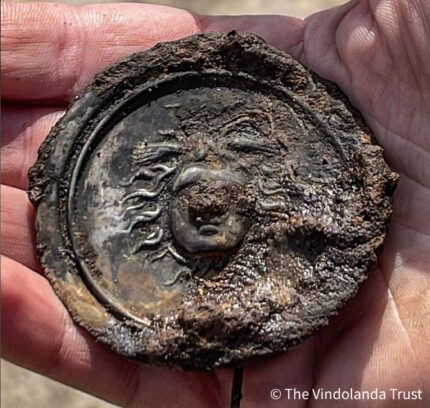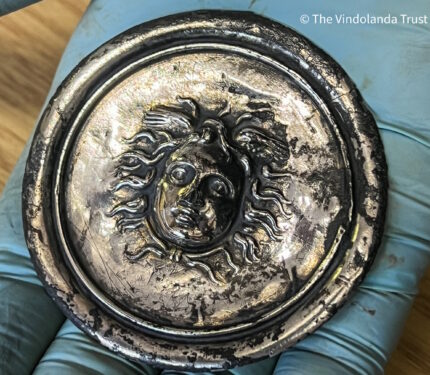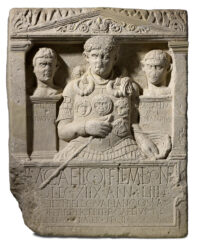 A volunteer digger at the Roman auxiliary fort of Vindolanda in Northumberland unearthed a rare silver phalera with a relief of the head of Medusa earlier this month. It was discovered on the floor of a barracks dating to the Hadrianic period of occupation in the 2nd century A.D.
A volunteer digger at the Roman auxiliary fort of Vindolanda in Northumberland unearthed a rare silver phalera with a relief of the head of Medusa earlier this month. It was discovered on the floor of a barracks dating to the Hadrianic period of occupation in the 2nd century A.D.
The silver disc has a raised rim with the bust of Medusa facing the viewer. She has wings on the top of her head and wild wavy hair, the prettified version of the formerly terrifying snake-haired gorgon. The only snakes on the portrait are two slim fellas tied in a knot under her chin like a bolo tie.
 Phalerae were worn by centurions and standard-bearers in the Roman legions, emblems of rank and valor. They came in sets of three to 10 roundels mounted on leather straps that buckled on the back. They could be plain discs or decorated with reliefs of deities, animals, mythological creatures or emperors. The Gorgon Medusa was a popular motif for phalerae, breastplates and other military accoutrements as her image was believed to be apotropaic (ie, have the power to ward off evil or bad luck).
Phalerae were worn by centurions and standard-bearers in the Roman legions, emblems of rank and valor. They came in sets of three to 10 roundels mounted on leather straps that buckled on the back. They could be plain discs or decorated with reliefs of deities, animals, mythological creatures or emperors. The Gorgon Medusa was a popular motif for phalerae, breastplates and other military accoutrements as her image was believed to be apotropaic (ie, have the power to ward off evil or bad luck).
An example comparable to the Vindolanda find is engraved on the tombstone of Roman centurion Marcus Caelius, notable as the only archaeological epigraphic source to explicitly reference the Varian disaster of 9 A.D. Marcus Caelius was the primus pilus (senior centurion)  of the XVIII Legion, one of the three legions Publius Quinctilius Varus led haplessly into an ambush in the Teutoburg Forest that would destroy them all and bring the Roman attempt to conquer Germany beyond the Rhine to a screeching halt. After his death in the calamitous battle, Caelius’ brother had the funerary stone erected in his honor. Now in the Rheinisches Landesmuseum in Bonn, the tombstone depicts the centurion wearing his phalerae. The central roundel, larger than the others, is a gorgoneion.
of the XVIII Legion, one of the three legions Publius Quinctilius Varus led haplessly into an ambush in the Teutoburg Forest that would destroy them all and bring the Roman attempt to conquer Germany beyond the Rhine to a screeching halt. After his death in the calamitous battle, Caelius’ brother had the funerary stone erected in his honor. Now in the Rheinisches Landesmuseum in Bonn, the tombstone depicts the centurion wearing his phalerae. The central roundel, larger than the others, is a gorgoneion.
Phalerae were valuable status symbols and would not have been intentionally discarded. The one at Vindolanda was probably lost by accident, much to its owner’s dismay. It is currently undergoing conservation and will be exhibited next year at the Vindolanda museum.
Instead of “B.C.”, the described “Hadrianic period of occupation” dates to the 2nd century “AD”, of course. – However, four hundred years give or take, that cleaned silver Phalera just looks ..Gorgeous!
Caelius’ tombstone is actually a cenotaph –which by the way should be spelled with ‘k’, κενός=empty. As his brothers’ inscription reads, “ossa inferre licebit”/ (his) “bones may be interred here”.
However, remains of those up to 20.000 Romans that had been found, were according to Bk.1 of Tacitus’ Annals later reburied locally on an expedition in 15AD:
—–
“…in the center of the field were the whitening bones of men, as they had fled, or stood their ground, strewn everywhere or piled in heaps. Near lay fragments of weapons and limbs of horses, and also human heads, prominently nailed to trunks of trees. In the adjacent groves were the barbarous altars, on which they had immolated tribunes and first-rank centurions.
Some survivors of the disaster who had escaped from the battle or from captivity, described how this was the spot where the officers fell, how yonder the eagles were captured, where Varus was pierced by his first wound, where too by the stroke of his own ill-starred hand he found for himself death. They pointed out too the raised ground from which Arminius had harangued his army, the number of gibbets for the captives, the pits for the living, and how in his exultation he insulted the standards and eagles.
And so the Roman army now on the spot, six years after the disaster, in grief and anger, began to bury the bones of the three legions, not a soldier knowing whether he was interring the relics of a relative or a stranger, but looking on all as kinsfolk and of their own blood, while their wrath rose higher than ever against the foe…”
—–